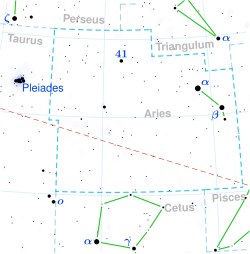Top Qs
Timeline
Chat
Perspective
Tau1 Arietis
Multiple star system in the constellation Aries From Wikipedia, the free encyclopedia
Remove ads
Tau1 Arietis is a triple star system[10] in the northern constellation of Aries. Its name is a Bayer designation that is Latinized from τ1 Arietis, and abbreviated Tau1 Ari or τ1 Ari. Based upon an annual parallax shift of 6.1786 mas, it is approximately 530 light-years (162 parsecs) distant from Earth. The combined apparent visual magnitude is 5.27,[3] making it faintly visible to the naked eye.

The Tau1 Arietis system contains three stars. The inner pair form an eclipsing binary system, with the brightness of the pair decreasing by 0.06 in magnitude during an eclipse of the primary.[12] This is a detached binary with an orbital period of 2.2035601139 days.[4] The third stellar component is located at an angular separation of 0.810 arcseconds and has a magnitude of 8.17.[10]
The primary component is a subgiant star with a stellar classification of B5 IV,[5] which suggests it is close to exhausting the supply of hydrogen at its core and evolving away from the main sequence. It has five times the mass of the Sun[7] with about four times the Sun's radius.[2] This star is around 55 million years old[7] and is spinning with a projected rotational velocity of 30 km/s.[8] It is radiating 234 times the luminosity of the Sun[1] from its photosphere at an effective temperature of 12,606 km/s.[2] Based on photometric data, the stellar light curve displays variability with periods of 1.105 and 1.492 days.[13] It has been classified as a candidate slowly pulsating B-type star.[14]
This system is a member of the Cas-Tau OB association of stars that share a common motion through space.[15]
Remove ads
References
External links
Wikiwand - on
Seamless Wikipedia browsing. On steroids.
Remove ads

